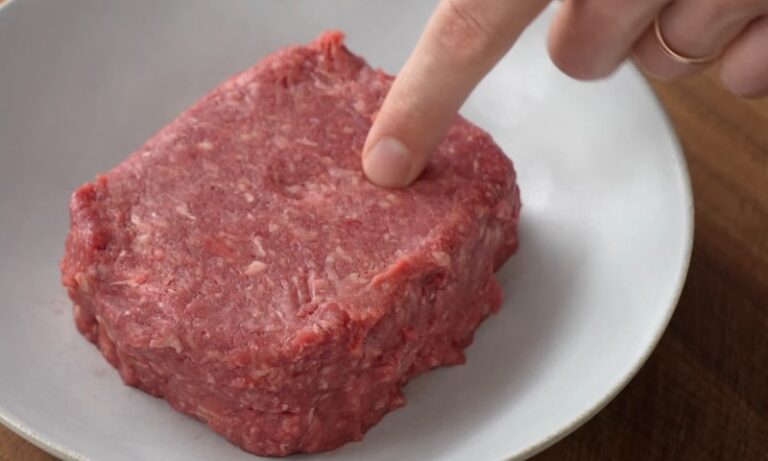Ground beef is a weeknight staple that shows up in everything from tacos to pasta sauces. But it is also one of the quickest foods to turn. Anyone who has ever opened a package and hesitated at a gray patch or strange odor knows the uncertainty that comes with judging meat freshness.
The good news is that you can tell with accuracy whether your ground beef is still safe to cook by paying attention to three key clues: color, smell, and texture. Add in storage time, and you will have a reliable system that works every time.
We prepared a guide backed by food safety authorities, showing what visual and sensory changes really mean, how to test without guesswork, and why time and temperature are the most important variables of all. Let’s begin.
Key Takeaways
- Check ground beef using color, smell, and texture, never just appearance.
- Store raw beef up to 2 days in the fridge or 3–4 months in the freezer.
- Cook to 160°F to kill bacteria like E. coli.
- Discard meat if it smells sour, feels slimy, or the package is swollen.
The One-Two-Three Rule for Checking Ground Beef
When you are deciding whether to keep or toss that package in the fridge, always follow this simple order:
- Check the date and storage time.
- Look for color and surface changes.
- Smell and touch for warning signs.
If any step raises a red flag, do not try to save it. As the USDA says, when in doubt, throw it out.
Why Color Can Mislead You
Color is often the first thing people notice when checking ground beef, but it can be deceptive. What looks bad isn’t always spoiled, and what looks fresh isn’t always safe.
The Myoglobin Story in Plain Terms
The color of beef comes from myoglobin , a natural muscle pigment that reacts with oxygen.
When freshly ground beef is exposed to air, oxygen binds to myoglobin and forms oxymyoglobin, the bright cherry-red color people associate with freshness. But color can shift even when the meat is still safe to eat.
Inside the package, oxygen does not circulate evenly. That is why the inside of a tightly packed tray or chub often looks gray or purplish . Once you open it, the interior can turn red again within minutes as oxygen reaches it.
Here’s what to watch for:
| Appearance | What It Means |
| Bright red on the surface, gray or brown inside after opening | Normal for tightly packed trays or chubs. Safe if time and smell check out. |
| Uniform brown or gray across the outside before opening | Warning sign. Color life may be over, or spoilage could have started. Check odor and texture next. |
Why Some Beef Stays Red Too Long
Certain packaging methods use modified atmosphere packaging (MAP) that may include trace carbon monoxide.
It stabilizes that attractive red color, even as the meat ages. That’s why color alone is never enough to judge safety. Always pair your visual check with smell and texture.
The Smell Test Is Your Fastest Warning Sign
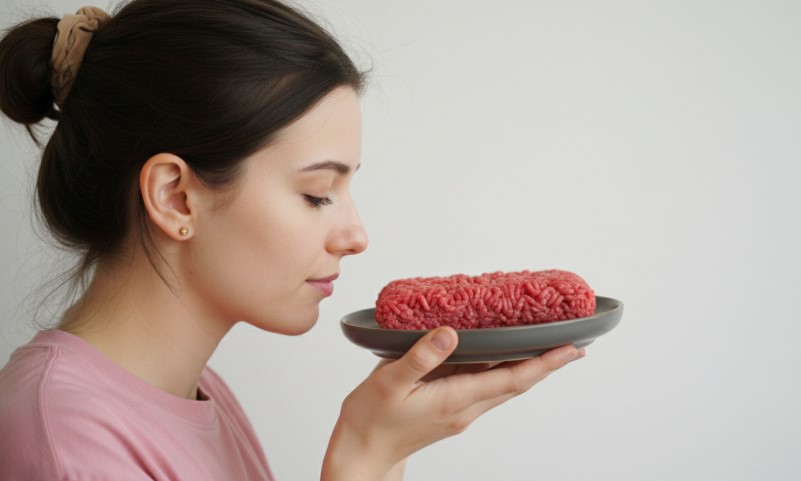
Fresh ground beef should have a clean, mild scent, something close to iron or fresh meat, not sour or stale. As bacteria multiply, they release compounds that produce a strong, unpleasant odor.
If you peel back the plastic and catch a whiff that makes you recoil, stop there. Spoiled ground beef often smells sour, metallic, or putrid .
Quick check method:
- Open the package.
- Step away for one breath of fresh air.
- Return and take one short sniff.
If it smells off or makes you pull back, it fails the test. No second opinions needed.
USDA consumer guidelines note that odor is one of the earliest signs of spoilage, often appearing before the texture changes.
Texture
Smell and sight may raise suspicion, but texture confirms it . Fresh ground beef feels slightly moist and breaks apart easily.
Spoiled meat develops a slimy or sticky layer that clings to your fingers. It might even stretch in thin strings when you pinch it.
If you feel any slickness or unusual tackiness, toss it. The surface film comes from bacteria growth, and it means the meat is no longer safe to eat.
Tip for Cleanup
Wash your hands, utensils, and any plate or countertop that touched suspect meat using hot, soapy water . Do not rinse raw beef in the sink, as splashing can spread bacteria around your kitchen.
Storage Times
@fooddolls How to store ground beef #beef #tipsandtricks #tips #HowTo #lifehacks #fooddolls
Even the freshest beef can turn dangerous if left too long or stored too warm. Ground beef has a shorter shelf life than whole cuts because grinding mixes surface bacteria throughout the meat. According to Food Safety:
| Product | Refrigerator (≤40°F) | Freezer (0°F) |
| Ground beef (raw) | 1 to 2 days | 3 to 4 months |
| Cooked ground beef | 3 to 4 days | 2 to 3 months |
What That Means at Home
- If you buy ground beef on Tuesday , plan to cook by Thursday or freeze it before then.
- If you freeze it the day you buy it , try to use it within 3 to 4 months for best flavor, though it stays safe longer if it remains fully frozen.
Date Labels
Date labels can be confusing. Here is what they actually mean:
| Label | Purpose |
| Sell-By | Helps stores manage stock. Meat is usually safe for 1–2 days after this date if refrigerated properly. |
| Best if Used By | Refers to quality, not safety. Flavor and color peak before this date. |
| Use-By | Manufacturer’s estimate of the last day for best quality. |
For meat, these are not safety deadlines . Federal law (except for infant formula) does not require discard dates. The key factor is how long you have kept it cold.
In 2024, federal agencies renewed efforts to simplify food date labels to reduce waste. The goal is to standardize around “Best if Used By” as a clearer signal for quality rather than a cutoff for safety.
The Three-Step Home Check
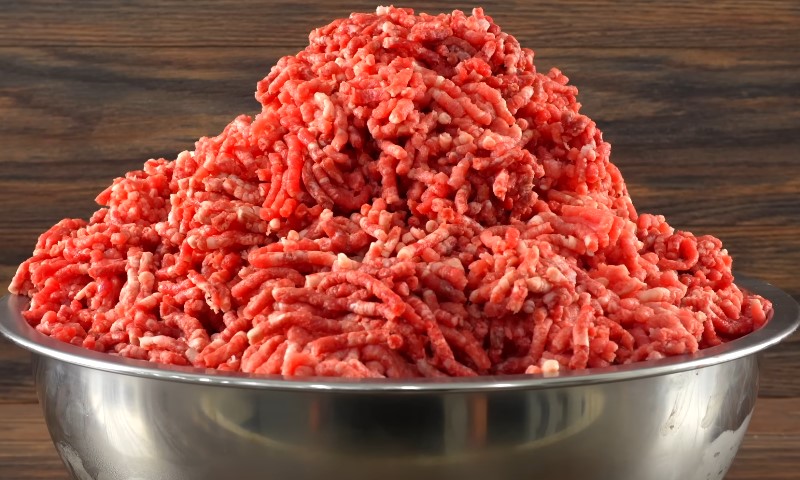
Here is how those tests work together in daily life.
Step 1: Confirm Time and Temperature
- Scenario A: You bought a pack yesterday and stored it below 40°F. You are within the 1–2 day limit—move on to the next step.
- Scenario B: It sat in the car for two hours on a hot afternoon. That’s the danger zone. Once food has been between 40°F and 140°F for more than 2 hours (or 1 hour if above 90°F), it’s no longer safe. Discard it.
Step 2: Look for Color and Surface Changes
- Normal: Red surface, gray interior once opened, minimal liquid, and no film.
- Warning: Entire surface looks brown or dull gray before opening, or any mold appears on cooked leftovers. Discard immediately if you see fuzzy growth.
Step 3: Smell and Touch
- Pass: Neutral scent and crumbly texture.
- Fail: Sour or rancid odor, sticky or slimy coating. Never try to “cook away” spoilage.
Why 160°F Is Non-Negotiable
Because grinding spreads bacteria throughout the meat, ground beef must reach 160°F (71°C) inside to be safe.
That’s the only way to kill harmful pathogens like E. coli O157:H7. Color can’t tell you if it’s done, as patties sometimes brown before hitting safe temperatures.
Cooking tips
- Use a food thermometer and insert it sideways into the center of patties or the thickest part of meatloaf.
- Don’t rely on color or “no pink juices.”
- Reheat leftovers to 165°F (74°C) .
Why It Matters
CDC estimates that 48 million Americans get foodborne illnesses each year. About 128,000 are hospitalized and 3,000 die .
Thawing and Refreezing Without Risk
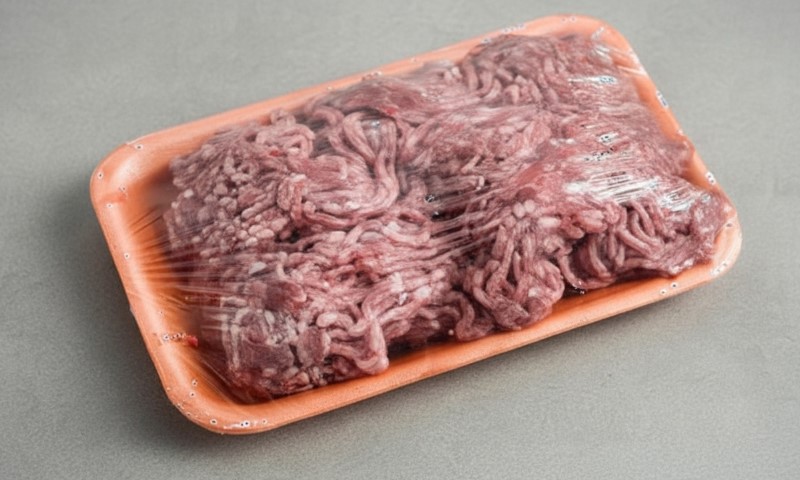
Freezing keeps ground beef safe for months, but how you thaw and refreeze it makes all the difference. A few simple steps protect both safety and texture.
Safe Thawing Methods
| Method | Description | Safety Note |
| Refrigerator thaw | Place sealed meat on a tray; small packs thaw overnight. | Safest and most controlled. |
| Cold-water thaw | Submerge in cold water; change water every 30 minutes. | Cook immediately after thawing. |
| Microwave thaw | Use defrost setting. | Cook right away after thawing. |
Never leave ground beef to thaw on the counter. That outer layer can reach unsafe temperatures long before the inside softens.
Can You Refreeze It?
Yes, if thawed in the refrigerator and kept below 40°F. You can refreeze raw or cooked ground beef, though texture may change slightly. Time in the fridge still counts toward the 1–2 day raw limit before cooking.
Packaging Clues Worth Checking
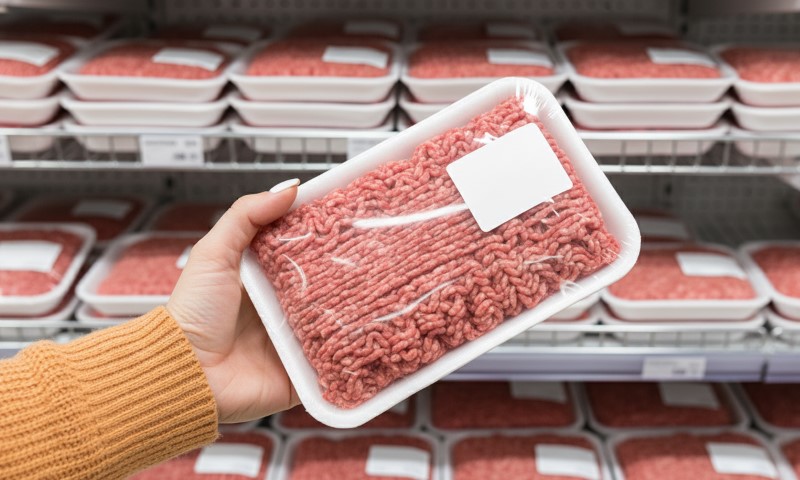
Packaging can reveal a lot before you even open it.
| Packaging Clue | What It Means |
| Tight, cold package with no tears | Good condition. |
| Bulging or broken seal | Spoilage gases may have formed. Discard if odor also present. |
| Red outside, gray inside | Normal oxygen variation. |
| Uniform brown before opening | Likely age or early spoilage. |
| Vacuum-sealed with purple tone | Normal; turns red once opened if still fresh. |
Safe Handling to Prevent Cross-Contamination
Even fresh meat can cause illness if mishandled, weather if it’s a beef or bacon. Keep things clean and separated.
- Use separate cutting boards for raw meat and vegetables.
- Wash hands and utensils with hot, soapy water after handling raw meat.
- Never rinse raw beef —it spreads bacteria through water droplets.
- Chill quickly: Refrigerate or freeze within 2 hours of purchase, or within 1 hour if it’s over 90°F outside.
Keep or Toss?
| Decision | Condition | Action |
| Keep and cook | Bought within 1–2 days, stored ≤40°F, red surface with some gray inside, clean smell, breaks apart easily | Cook to 160°F and enjoy |
| Toss immediately | Off or putrid odor, sticky or slimy texture, bulging package with gas, brown or gray outside plus odor, or sat above 40°F for over 2 hours | Discard safely |
Extra Tips for Safer Kitchens
- Place a small fridge thermometer on the middle shelf. Check weekly to ensure it stays at 40°F or below.
- Keep freezer temperature at 0°F or lower.
- Freeze ground beef in flat portions or thin bags—it thaws faster and cooks evenly.
- Label freezer packs with the date so you can track the 3–4 month window.
- For families with kids or older adults, err on the side of caution with smell and texture tests.
FAQs
Final Safety Reminders
- Always cook ground beef to 160°F and reheat leftovers to 165°F .
- Respect time and temperature limits: 1–2 days in the fridge, 3–4 months in the freezer.
- Rely on your senses, but back them with a thermometer.
- Keep the refrigerator cold, clean, and organized to prevent cross-contamination.
The combination of color, smell, texture, and time is your best safety net. Once you get used to checking all three, judging ground beef becomes second nature. It takes only a few seconds and saves you from guessing, or worse, getting sick.

